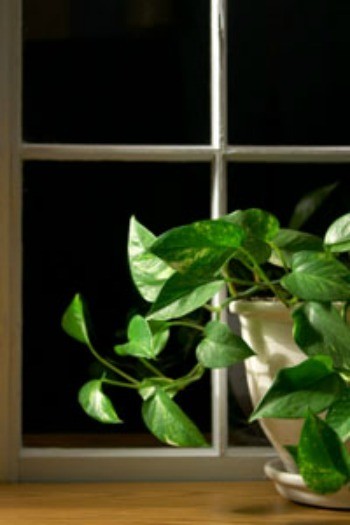
If you find that you have a brown thumb when it comes to growing houseplants, existing light conditions may be the biggest factor standing in the way of you and success. Selecting plants to grow indoors is similar to selecting plants to grow outdoors. But instead of selecting the right plant for the right site, you need to choose your houseplants based on your available light.
The amount of windows, the direction they face, and curtains and blinds all have an impact on light levels. And although no indoor plants will grow without light, many are capable of adapting to low-light conditions. Low light areas, for example, interior areas like coffee tables that are well away from windows, can be defined as a poorly lit areas where there is still enough natural light available to read a book or newspaper. In houseplant books, low light plants may be referred to as shade plants.
Light intensity requirements vary from plant to plant. Low light plants need between 50 and 250 foot-candles of light intensity. ( A foot candle is the amount of light received by by 1 square ft of surface area, located 1 ft away from a candle.) Under artificial lights, some low light plants can be maintained at as little as 10 foot-candles.The duration requirements among plants (the amount of light available to a plant each day) are more constant. Plants need somewhere in the range of 12-16 hours of light each day to maintain active growth. This can be maintained with natural or artificial lights, but any less, and growth slows.
A lack of windows at the office is all the more reason to fill it with plants, and many low-light plants adapt well to this environment. Not only do they add color and warmth to an otherwise sterile environment, but introducing an element of nature into a stressful environment has a calming and soothing effect on one's nerves. As an added benefit, they clean and purify the air. The plants listed below can be maintained reasonably well in an office environment using only fluorescent lights.
These plants are willing to adapt to less than ideal light conditions, but in return, special attention should be taken to ensure that their other growing requirements are met. Finding out exactly what those requirements are will require some research on your part. Care begins with the soil. Use a good quality potting soil and be careful not to over water them. Container plants depend on you to receive their nutrients, so to keep them happy, keep them fed. Most low light indoor plants like reasonably warm temperatures (similar to an average house), but they vary in humidity requirements.
In general, flowering houseplants and plants with colored foliage grow best in more light.
And while some can be maintained in lower light, blooms are poor (or non-existent) and foliage tends to fade. An easy way to add color and interest is by using decorative containers. Instead of going with a solid color or traditional shape, use pots with bright patterns and containers with interesting shapes. Add whimsical plant stakes or small figurines to pots and planters for a personalized touch.

About The Author: Ellen Brown is an environmental writer and photographer and the owner of Sustainable Media, an environmental media company that specializes in helping businesses and organizations promote eco-friendly products and services. Contact her on the web at http://www.sustainable-media.com
Add your voice! Click below to comment. ThriftyFun is powered by your wisdom!
Thank you, I'll use those botanical names and do websearches with them, and fill our almost-windowless office with some life and oxygen!
Add your voice! Click below to comment. ThriftyFun is powered by your wisdom!